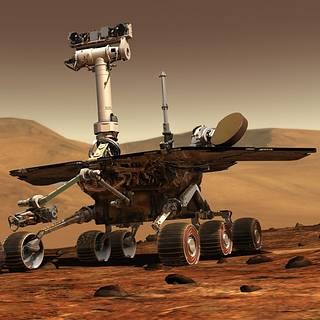NASA’s Perseverance Rover Sets Foot on Mars
The rover, seeking to find signs of past or present life on the barren planet, will cover the Martian terrain in an exploration that will pave the way for future human missions.

NASA’s Perserverance Rover, pictured here, will explore the Martian surface on a mission that will help outline the future of space travel.
Blast off!
On July 30th, 2020, NASA’s Perseverance Rover took flight, beginning its months-long journey through space on its way to Mars. After seven months of travel, the rover landed on February 18th, 2021 to the great excitement of people all across the globe. Now, the rover will search for past or present life on Mars and, if found, could impact the realm of space and science like never before.
NASA began constructing the Perseverance Rover back in 2012, as the next rover to follow Curiosity, a rover sent to Mars in 2011. After eight years of building and testing, the Perseverance Rover was ready to go.
Once the rover landed on Mars, it immediately got to work. Only a couple of hours after landing, the rover sent its first images, which displayed the planet’s rocky surface, back to Earth. Days later, it released its first set of aerial shots, which NASA downloaded onto its photo database for the world to see. The rover also sent back sounds captured from landing and tracking, using the most advanced microphones to be equipped on a planetary rover.
Weighing nearly a ton, the rover is one of a kind. It has seventeen cameras, six wheels for movement, drillers, storage for collecting samples, and a small robotic helicopter attached underneath named Ingenuity. Ingenuity will be the first helicopter to fly on another planet at some point in April 2021, rising up into the Martian atmosphere for around 20 seconds on its first flight. Ingenuity’s flight has been hailed as “an extraterrestrial Wright Brothers moment,” marking how truly significant its flight will be. If successful, the helicopter will attempt longer flights, which will help map out terrain and measure atmospheric levels of certain gases and pollutants.
The rover will traverse the Martian surface for one Mars year, lasting 668 sols, equivalent to 687 earth days (around two years). Throughout its journey, Perseverance will cover nearly 30 miles around the Jezero Crater, thought to be an eroded delta of a lake that once existed on the planet millions of years ago. There, the rover will dig up samples and search for evidence of past or present life on the barren planet. The samples that are gathered will be cached on the planet’s surface until a future mission retrieves those samples and returns them to Earth for inspection in a lab.
The project has stirred great excitement, with general audiences excitedly tuning in. Much of this is due to social media, as NASA’s JPL (Jet Propulsion Lab) controls the rover’s twitter account, which keeps its nearly 2.7 million followers up to date on the progress of the mission.
There has also been enthusiasm among experts, with many giving great praise to the mission and the rover itself. On a recent appearance on the Late Show with Stephen Colbert, astrophysicist and Bronx Science alumnus Neil DeGrasse Tyson (‘76) spoke on the importance of the rover. Tyson was very enthusiastic about the project, saying “It’s got a helicopter!” Susanna Schrobsdorff of Time Magazine called the rover “a car-sized cosmic miracle of engineering and optimism,” while others in the scientific community have kept their opinions brief, simply calling it “stunning.”
The Perseverance Rover mission also seeks to establish a gateway towards human exploration of Mars. By testing carbon dioxide levels and observing the terrain, the rover can identify potential locations suitable for humans to safely explore and land. Ingenuity will further expand knowledge on this topic by marking spots during its flight that can be sent back to NASA.
If the rover is successful in its mission, the next step, NASA hopes, is human exploration. NASA has targeted a timeframe between seven to 15 years to put the first humans on Mars, but others have more ambitious timelines. SpaceX CEO Elon Musk has pursued 2024 for the first human mission, but his timeline is seen as impossible due to general logistics, planning, construction, and lots of testing.
The future of space exploration looks bright. Publicity and the prospects of space travel and exploration have created a lot more excitement about the realm of space. If the Perseverance Rover is successful and NASA fulfills its plan for human exploration to Mars in the near future, society should be prepared for a new era of space exploration, one with more excitement, curiosity, and potential than ever before.
Now, the rover will search for past or present life on Mars and, if found, could impact the realm of space and science like never before.
Ethan Weinberg is an Editor-in-Chief for 'The Science Survey.” Ethan enjoys journalistic writing, as he believes that by making sense of the issues on...
